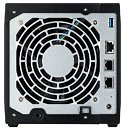- Joined
- Oct 9, 2007
- Messages
- 46,768 (7.63/day)
- Location
- Hyderabad, India
| System Name | RBMK-1000 |
|---|---|
| Processor | AMD Ryzen 7 5700G |
| Motherboard | ASUS ROG Strix B450-E Gaming |
| Cooling | DeepCool Gammax L240 V2 |
| Memory | 2x 8GB G.Skill Sniper X |
| Video Card(s) | Palit GeForce RTX 2080 SUPER GameRock |
| Storage | Western Digital Black NVMe 512GB |
| Display(s) | BenQ 1440p 60 Hz 27-inch |
| Case | Corsair Carbide 100R |
| Audio Device(s) | ASUS SupremeFX S1220A |
| Power Supply | Cooler Master MWE Gold 650W |
| Mouse | ASUS ROG Strix Impact |
| Keyboard | Gamdias Hermes E2 |
| Software | Windows 11 Pro |
ASUSTOR Inc. has announced today that two new NAS devices will be joining the ASUSTOR family. The AS4002T and AS4004T are our first consumer NAS that integrate 10gb Ethernet with an RJ45 connector. The AS4002T and AS4004T are the world's first NAS containing a Marvell Armada Cortex-A72 64-bit dual-core processor. Compared with the previous generation of processors, these NAS offer 3½ times more computing power. 2GB of DDR4-2400 memory is also included, which is faster and more efficient than DDR3. Both the AS4002T and AS4004T have a 10gb Ethernet port and two Gigabit Ethernet ports, which create a fast networking environment that is 10 times faster than a Gigabit network. Network aggregation technology can also be used to combine the three RJ45 ports to triple the speed of a gigabit connection without 10gb hardware.
The new AS4002T and AS4004T come with a brand new appearance. The front panel is a removable crystal black magnetic panel, which is not only aesthetically pleasing but also dust-proof. Actuated inlets are arranged around the panel to optimize heat transfer, while the inner honeycomb structure strengthens the pressure area to avoid damaging hard drives from external impact. In addition, both models support hot-swapping hard drives. The hard disk is fully secured using the caddy, and the hard drives can be quickly installed or replaced without any tools.






ASUSTOR product manager Johnny Chen pointed out: " Both beginners and professionals will be more than satisfied with the excellent performance and convenience brought by these two new NAS. It is worth mentioning that a 10-Gigabit network and the full set of equipment is required to achieve maximum speeds. The AS40 series is affordable for both consumers and businesses. We are very pleased to be releasing a NAS that both consumers and businesses will find to be one of the best values for a NAS."
The AS40 series is sold with the latest version of ADM. Once initialized by the installation wizard, this fully-featured ASUSTOR NAS can be used immediately to experience the convenience of remote storage management, backup, and sharing of data anywhere and anytime.
AS4002T and AS4004T Specifications
View at TechPowerUp Main Site
The new AS4002T and AS4004T come with a brand new appearance. The front panel is a removable crystal black magnetic panel, which is not only aesthetically pleasing but also dust-proof. Actuated inlets are arranged around the panel to optimize heat transfer, while the inner honeycomb structure strengthens the pressure area to avoid damaging hard drives from external impact. In addition, both models support hot-swapping hard drives. The hard disk is fully secured using the caddy, and the hard drives can be quickly installed or replaced without any tools.






ASUSTOR product manager Johnny Chen pointed out: " Both beginners and professionals will be more than satisfied with the excellent performance and convenience brought by these two new NAS. It is worth mentioning that a 10-Gigabit network and the full set of equipment is required to achieve maximum speeds. The AS40 series is affordable for both consumers and businesses. We are very pleased to be releasing a NAS that both consumers and businesses will find to be one of the best values for a NAS."
The AS40 series is sold with the latest version of ADM. Once initialized by the installation wizard, this fully-featured ASUSTOR NAS can be used immediately to experience the convenience of remote storage management, backup, and sharing of data anywhere and anytime.
AS4002T and AS4004T Specifications
- Marvell Armada Cortex-A72 1.6GHz dual core CPU
- 2GB of DDR4-2400 RAM
- 2x Gigabit Ethernet ports
- 1x 10-Gigabit Ethernet ports
- Read speeds of up to 1146MB/s on RAID 5
- Write speeds of up to 584 MB/s on RAID 5
- Front panel USB 3.1 Gen1, power button, one-touch backup button.
- Rear USB 3.1 Gen1
- Supports hard drive hot swapping
- Tool-less installation
- Supports hardware encryption
- Supports JBOD, single drives, and RAID levels 0 and 1 while quad bay units also support levels 5, 6 and 10
- Supports up to 12TB per hard drive
- Supports seamless system migration
- Supports MyArchive drives
View at TechPowerUp Main Site

